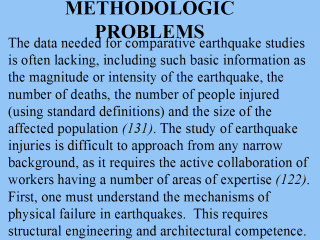 |
Second, one must
understand the process of human injury in earthquake-induced building
failure. Third, one must develop the analytical framework for the analysis
of injury patterns and for the analysis of the relationship between specific
causative agents and negative consequences (129). Furthermore, the
causal mechanisms and nature of earthquake-related injuries are difficult to
determine precisely, as are the appropriate variables and indicators
describing such injuries. One must consider hazard exposure; construction
types and their performance during earthquakes; the influence of
nonstructural components, building components, and building contents;
building occupancy and the behavior of occupants; emergency and rescue
response; and medical treatment provided. Not surprisingly, one is soon
faced with the problem that such information is very difficult to collect
because it must be collected immediately after the impact when conditions
are most chaotic and all qualified personnel are directed to the primary
life-saving effort (132). This use of personnel is, in most cases,
justifiable; however, without the active assistance of search and rescue
personnel, "backtracking" injuries from hospitals to specific
building-collapse sites may be impossible. |
